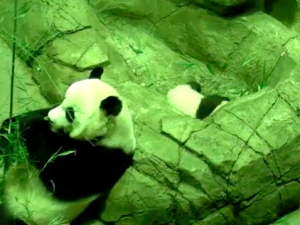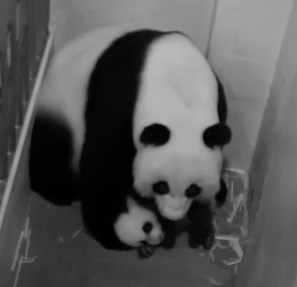Ever since I visited my first national zoo, the Giant Panda became the best living creature to me. In this post, I will tell you about the Giant Panda, Also known as the panda, or just panda. Panda’s are adorable and fuzzy bears that comes from south central China is going extinct. Most people recognize them by their large, distinctive black patches around its eyes, over the ears, and across its round chubby body.
 Violet via Panda Cam
Violet via Panda Cam
Mei, the giant panda mother eating bamboo while watching her cub Bei sleep.
The name of ‘Giant Panda’ is often used to differ it from the totally unrelated Red Panda. Though it belongs to the diet Carnivora, the panda’s diet is over 99% bamboo. Pandas in the wild will sometimes eat other grasses, meat, or rodents. When in captivity, they are fed prepared food. The panda live near a few mountains in central China, mainly in Sichuan Province, but also in other provinces, some known as Shaanxi and Gansu. Because of the farming, deforestation, and other happenings, the giant panda has been forced out of the areas where they used to live.
The giant pandas are relying on the conservation from people all around the world, to keep them from going extinct. A 2007 report shows 239 pandas living in captivity inside `China and another 27 outside the country. On December 2014, 49 giant pandas live in captivity outside China, living in 18 zoos in 13 different countries. Some reports also show that the number of giant pandas in the wild is rising. While the dragon has often served as China’s national sign, globally the giant panda appears almost the same amount as the dragon. It is becoming used within China a lot in international happenings. For example as one of the five mascots of the Beijing Olympics.
Here are some facts about the giant panda:
- 1,864 wild giant pandas were counted during a 2014 survey
- An adult panda can weigh about 100-150kg and grow up to 150cm long
- Pandas feed for up to 14 hours a day and can eat up to 38kg of bamboo
- When born, a panda cub is just 1/900th the size of its mother
- Pandas are good swimmers and excellent tree climbers
- Habitat loss and fragmentation are major threats
Mother panda’s are very protective over their cubs, as shown by the mother panda Mei and cub Bei in the National ZooViolet via Panda Cam